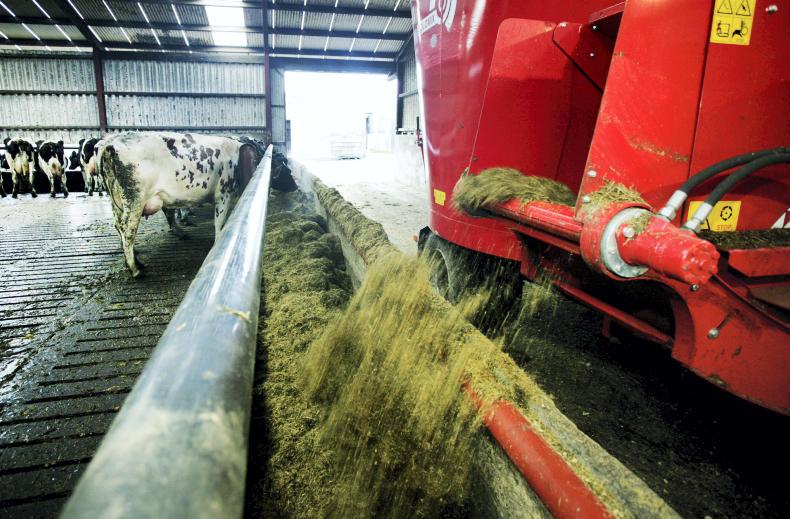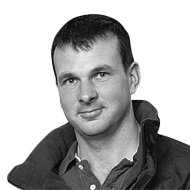By now, all cattle are housed and we have settled into the winter routine. All silos are now opened and with the exception of third-cut, forage quality is good.
Compared to last year, production is 2l/cow to 3l/cow ahead, with milk solids percentages around the same level (30l at 3.51% protein and 4.41% butterfat, equating to 2.4kg solids from a feed rate of 0.39kg/l).
My first-cut silage has analysed at 35% dry matter (DM), 17.7% protein, 11.3 ME, 70 D-value and with a pH of 4.2.
The wholecrop rye is in the pit at 28% DM, 9% protein, 10 ME and 28% starch.
I would go as far as to say that the first-cut silage is actually feeding better than the analysis would suggest. After being disappointed with last year’s silage, I decided this year to use an additive for the first time in a few years. At this point, I think that the investment was money well spent.
Calving
Autumn calving continues to go well. To date, we have over 70 cows calved and I have probably only had to give assistance to around half a dozen or so.
I have made a conscious effort to give cows more time at calving and it seems to be paying off.
Transition cows are checked regularly throughout the day, and I try to leave cows in the cubicles for as long as possible before moving them to calving pens.
By getting them into the calving pen just in time, cows seem to lie down and calve straight away. As a result, the benefits are clear to see – calf mortality is lower, there have only been two cows that have held cleanings, and there is less metritis.
I am also in the habit of checking the temperatures of heifers after calving and have noticed a lot fewer with raised temperatures around days seven to 10 after calving.
Antibiotics
All this has resulted in cows, and in particular heifers, getting off to a much better start and we are using a lot less antibiotics in the early lactation period, which means less milk has to be dumped. Sexed semen also plays a part in this as it leads to easier calvings in general.
With breeding due to kick off in the next couple of weeks, cows are starting to show good signs of heat.
This year, I plan to use more sexed semen and pay closer attention to milk records so that I can then use beef semen on the lower-end animals.
To take this approach to its logical conclusion, I am starting to come round to the idea of genomically testing the heifer calves. This will help identify the heifers that are going to allow the herd to make the most genetic progress. It should also help pinpoint any potential passengers.
Bull selection
In terms of bull selection, this year I have set the bar at plus 500kg of milk with a strong emphasis on fertility, milk solids, calving ease and average or negative stature.
Bulls in the tank this year include Seagull-bay Stardust, Bomaz Skywalker, Charming, ABS Sassafras and Kimball.
However, with so many sires to choose from and an ever decreasing gene pool, inbreeding is becoming an issue.
I think it is only a matter of time before we are all using computer programs to select matings to avoid potential problems. This will be a useful tool, but for me I can’t help but think it will remove the enjoyment I get from breeding cows.
Read more
Watch: sexed semen brings lots of heifer calves
Farmer Writes: lots of grass but the high-yielders staying in
By now, all cattle are housed and we have settled into the winter routine. All silos are now opened and with the exception of third-cut, forage quality is good.
Compared to last year, production is 2l/cow to 3l/cow ahead, with milk solids percentages around the same level (30l at 3.51% protein and 4.41% butterfat, equating to 2.4kg solids from a feed rate of 0.39kg/l).
My first-cut silage has analysed at 35% dry matter (DM), 17.7% protein, 11.3 ME, 70 D-value and with a pH of 4.2.
The wholecrop rye is in the pit at 28% DM, 9% protein, 10 ME and 28% starch.
I would go as far as to say that the first-cut silage is actually feeding better than the analysis would suggest. After being disappointed with last year’s silage, I decided this year to use an additive for the first time in a few years. At this point, I think that the investment was money well spent.
Calving
Autumn calving continues to go well. To date, we have over 70 cows calved and I have probably only had to give assistance to around half a dozen or so.
I have made a conscious effort to give cows more time at calving and it seems to be paying off.
Transition cows are checked regularly throughout the day, and I try to leave cows in the cubicles for as long as possible before moving them to calving pens.
By getting them into the calving pen just in time, cows seem to lie down and calve straight away. As a result, the benefits are clear to see – calf mortality is lower, there have only been two cows that have held cleanings, and there is less metritis.
I am also in the habit of checking the temperatures of heifers after calving and have noticed a lot fewer with raised temperatures around days seven to 10 after calving.
Antibiotics
All this has resulted in cows, and in particular heifers, getting off to a much better start and we are using a lot less antibiotics in the early lactation period, which means less milk has to be dumped. Sexed semen also plays a part in this as it leads to easier calvings in general.
With breeding due to kick off in the next couple of weeks, cows are starting to show good signs of heat.
This year, I plan to use more sexed semen and pay closer attention to milk records so that I can then use beef semen on the lower-end animals.
To take this approach to its logical conclusion, I am starting to come round to the idea of genomically testing the heifer calves. This will help identify the heifers that are going to allow the herd to make the most genetic progress. It should also help pinpoint any potential passengers.
Bull selection
In terms of bull selection, this year I have set the bar at plus 500kg of milk with a strong emphasis on fertility, milk solids, calving ease and average or negative stature.
Bulls in the tank this year include Seagull-bay Stardust, Bomaz Skywalker, Charming, ABS Sassafras and Kimball.
However, with so many sires to choose from and an ever decreasing gene pool, inbreeding is becoming an issue.
I think it is only a matter of time before we are all using computer programs to select matings to avoid potential problems. This will be a useful tool, but for me I can’t help but think it will remove the enjoyment I get from breeding cows.
Read more
Watch: sexed semen brings lots of heifer calves
Farmer Writes: lots of grass but the high-yielders staying in






 This is a subscriber-only article
This is a subscriber-only article










SHARING OPTIONS: